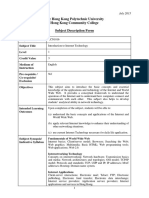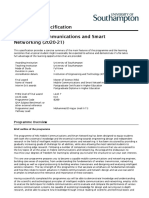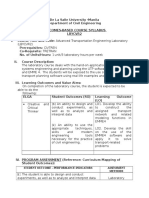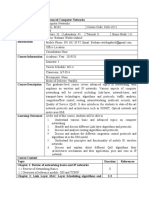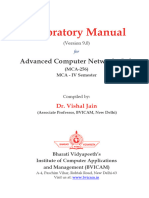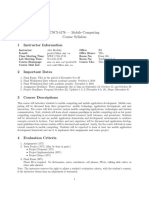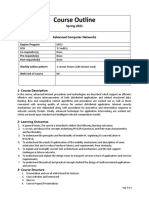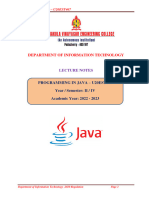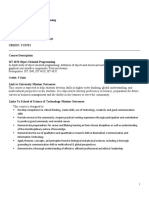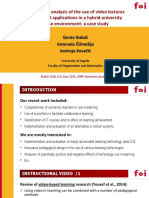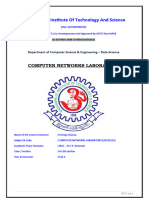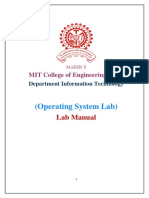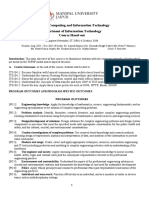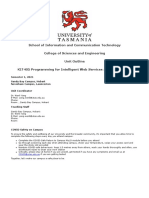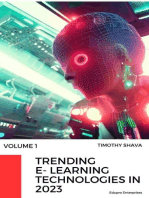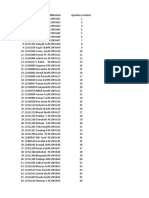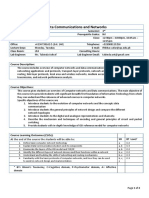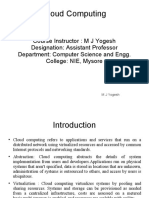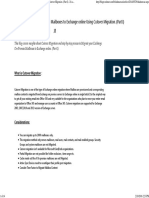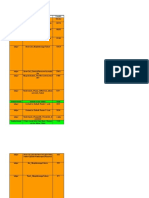Professional Documents
Culture Documents
Eie575 20231
Eie575 20231
Uploaded by
jiaoguangyi666Original Description:
Original Title
Copyright
Available Formats
Share this document
Did you find this document useful?
Is this content inappropriate?
Report this DocumentCopyright:
Available Formats
Eie575 20231
Eie575 20231
Uploaded by
jiaoguangyi666Copyright:
Available Formats
Subject Description Form
Subject Code EIE575
Subject Title Vehicular Communications and Inter-Networking Technologies
Credit Value 3
Level 5
Pre-requisite/ The students are expected to have some basic knowledge about wireless
Co-requisite/ communications, computer networks and mobile ad-hoc networks. Extra materials
Exclusion will be provided for self-learning before the commencement of the course on request
for those who do not have the appropriate knowledge. Please contact the subject
lecturer for details.
Objectives This subject will introduce students with the emerging technologies, standards and
applications in vehicular communication systems. The students will study the design
considerations and challenges of vehicle-to-infrastructure and vehicle-to-vehicle
communications. Theories such as vehicular mobility modeling, and vehicular
technologies and standards from the physical to network layers will be introduced in the
course. Examples of emerging applications of vehicular communications in Intelligent
Transportation Systems will also be studied and discussed.
Intended Learning Upon completion of the subject, students will be able to:
Outcomes (1) Professional/academic knowledge and skills
a. Understand and describe the basic theories and principles, technologies,
standards, and system architecture of vehicular ad-hoc networks (VANET) or
inter-vehicle communication networks.
b. Analyze, design, and evaluate vehicular communication platforms for various
kinds of safety and infotainment applications.
(2) Attributes for all-roundedness
c. Communicate effectively.
d. Think critically and creatively.
e. Assimilate new technological development in related fields.
Subject Synopsis/ 1. Introduction
Indicative Syllabus Basic principles and challenges, past and ongoing VANET activities
2. Cooperative Vehicular Safety Applications
Enabling technologies, cooperative system architecture, safety applications
3. Vehicular Mobility Modeling
Random models, flow and traffic models, behavioral models, trace and survey-based
models, joint transport and communication simulations
4. Physical Layer Considerations for Vehicular Communications
Signal propagation, Doppler spread and its impact on OFDM systems
5. MAC Layer of Vehicular Communication Networks
Proposed MAC approaches and standards, IEEE 802.11p
6. VANET Routing protocols
Opportunistic packet forwarding, topology-based routing, geographic routing
7. Emerging VANET Applications
Limitations, example applications, communication paradigms, message coding and
composition, data aggregation
8. Standards and Regulations
Regulations and Standards, DSRC Protocol Stack, Cellular V2X
Teaching/Learning The theories and applications of VANET will be described and explained in lectures.
Methodology Techniques and parameters for evaluating various vehicular communication platforms
will be presented in tutorials. Students are requested to review latest research papers on
VANET and study in detail some selected vehicular communication platforms and
their potential applications. Finally, share their findings with other classmates through
two presentations and write a report to summarize their findings.
Teaching/Learning Methodology Intended Subject Learning Outcomes
a b c d e
Lectures
Tutorials
Assignments
Mini project/Presentations
Assessment Methods
in Alignment with Specific assessment % Intended subject learning outcomes to be
methods/tasks weighting assessed (Please tick as appropriate)
Intended Learning
Outcomes a b c d e
1. Paper Review 10%
2. Survey Report 15%
3. Test/Quizzes 20%
4. Lab 5%
5. Mini project 50%
Total 100%
Explanation of the appropriateness of the assessment methods in assessing the
intended learning outcomes:
Paper review, survey report, test/quizzes, and lab exercises let students review the
taught materials, do further reading for deeper learning and apply the learnt materials
to solving common vehicular communication network problems.
The mini project requires the student to do further reading, search for information,
keep abreast of current development, give presentations and prepare written report.
Student Study Class contact:
Effort Required
Lecture/Tutorial/Lab 33 Hrs.
Presentation 6 Hrs.
Other student study effort:
Lecture: further reading, doing homework/
30 Hrs.
assignment
Mini-project: studying, writing a report, preparing
40 Hrs.
two presentations
Total student study effort 109 Hrs.
Reading List and Text book:
References 1. H. Hartenstein and K. P. Laberteaux, VANET: Vehicular Applications and Inter-
Networking Technologies, Wiley, 2010.
Reference books:
1. P. H.-J. Chong, I. W.-H. Ho, Vehicular Networks: Applications, Performance
Analysis and Challenges, Nova Science Publishers, 2019.
2. C. Sommer, F. Dressler, Vehicular Networking, Cambridge University Press,
2015.
3. M. Emmelmann, B. Bochow and C. C. Kellum, Vehicular Networking:
Automotive Applications and Beyond, Wiley, 2010.
4. M. Watfa, Advances in Vehicular Ad-Hoc Networks: Development and
Challenges, Information Science Reference, 2010.
5. H. Moustafa, Y. Zhang, Vehicular Networks: Techniques, Standards, and
Applications, CRC Press, 2009.
Others:
1. IEEE Transactions and other journals.
July 2022
You might also like
- Sithu CNDocument26 pagesSithu CNSithu KhantNo ratings yet
- CCN1016 Introduction To Internet Technology PDFDocument3 pagesCCN1016 Introduction To Internet Technology PDFdnlkabaNo ratings yet
- IS2102 Data Communication Course Handout Aug-Dec23Document8 pagesIS2102 Data Communication Course Handout Aug-Dec23Shrishti ChordiaNo ratings yet
- Intro To Hci PDFDocument12 pagesIntro To Hci PDFLeary John TambagahanNo ratings yet
- Programme Specification MSC Mobile Communications and Smart Networking (2020-21)Document10 pagesProgramme Specification MSC Mobile Communications and Smart Networking (2020-21)JosephNo ratings yet
- Working Model For Car Engine and Lighting Simulation Improvised As Iot Learning Device For AutotronicsDocument5 pagesWorking Model For Car Engine and Lighting Simulation Improvised As Iot Learning Device For AutotronicsJohn Huss TongcoNo ratings yet
- Subject Description FormDocument3 pagesSubject Description FormDaniela HossuNo ratings yet
- Course File - Cse - Daa 2022-23 VenkatDocument60 pagesCourse File - Cse - Daa 2022-23 VenkatSatish BabuNo ratings yet
- Course Handout-Computer Networks - CS1602Document9 pagesCourse Handout-Computer Networks - CS1602none nadaNo ratings yet
- 7030maa 2021 Applied CoreDocument9 pages7030maa 2021 Applied Coremayo ABIOYENo ratings yet
- Inf 403 Mobile and Distributed ComputingDocument4 pagesInf 403 Mobile and Distributed Computingbysschearthur123No ratings yet
- Student Outcome - Performance Indicators Assessment MethodsDocument5 pagesStudent Outcome - Performance Indicators Assessment MethodsKim SanchezNo ratings yet
- STM NotesDocument153 pagesSTM NotespraveennallavellyNo ratings yet
- DCN Course Module - Sep 2013Document30 pagesDCN Course Module - Sep 2013Khalid AliNo ratings yet
- William WorkDocument14 pagesWilliam WorkWilliam Jacob Ekow SamNo ratings yet
- C++ Couse File 20-21Document63 pagesC++ Couse File 20-21swapnaNo ratings yet
- L0 MarkingSchemeDocument14 pagesL0 MarkingSchemeRohit SenNo ratings yet
- Advanced Computer Networks-OutlineDocument3 pagesAdvanced Computer Networks-OutlinebetelihemNo ratings yet
- Professional/academic Knowledge and SkillsDocument4 pagesProfessional/academic Knowledge and SkillsVikas NagareNo ratings yet
- School of Information and Communication Technology College of Sciences and Engineering Unit Outline KIT613 Human Computer InteractionDocument12 pagesSchool of Information and Communication Technology College of Sciences and Engineering Unit Outline KIT613 Human Computer InteractionShahid AhmedNo ratings yet
- Computer ProgrammingDocument14 pagesComputer ProgrammingLOL TimeNo ratings yet
- Ai & ML Lab ManualDocument41 pagesAi & ML Lab ManualAnand DuraiswamyNo ratings yet
- CCP313 Object Oriented Programming - FT v2Document4 pagesCCP313 Object Oriented Programming - FT v2roshan kc100% (1)
- ACN Lab Manual - 0Document23 pagesACN Lab Manual - 0AhmedNo ratings yet
- Java - Lesson PlanDocument14 pagesJava - Lesson PlanGeetha A LNo ratings yet
- CSCI-4176 - Mobile Computing Course Syllabus 1 Instructor InformationDocument3 pagesCSCI-4176 - Mobile Computing Course Syllabus 1 Instructor InformationRabin KasulaNo ratings yet
- Outcomes-Based Concept Module Development For Systems For Smart CommunicationsDocument7 pagesOutcomes-Based Concept Module Development For Systems For Smart CommunicationstaksasNo ratings yet
- Model Based Learning of Linear Integrated Circuit Course: A Practical ApproachDocument6 pagesModel Based Learning of Linear Integrated Circuit Course: A Practical ApproachSimrandeep SinghNo ratings yet
- MCC Online Notes 2021-22-5 UnitsDocument183 pagesMCC Online Notes 2021-22-5 UnitsUDAYA ALLANINo ratings yet
- Midterm Project - Emerging HCI TechnologiesDocument6 pagesMidterm Project - Emerging HCI TechnologiesAshley BruasNo ratings yet
- ACN Course OutlineDocument4 pagesACN Course OutlineAfshan Bilal-MS 009No ratings yet
- OBTLP - CC 2104 - Applications Development and Emerging TechnologiesDocument6 pagesOBTLP - CC 2104 - Applications Development and Emerging TechnologiesJoselle A. BanocnocNo ratings yet
- OrugaMoniqueCaila (BSEE) @library Research 3Document9 pagesOrugaMoniqueCaila (BSEE) @library Research 3Monique Caila OrugaNo ratings yet
- Java Lecture NotesDocument226 pagesJava Lecture Notesbhanuj gunaNo ratings yet
- CS 466 CS 5613 Human Computer Interaction Human Computer Interaction Design Suleman Shahid 1 PDFDocument3 pagesCS 466 CS 5613 Human Computer Interaction Human Computer Interaction Design Suleman Shahid 1 PDF20100095No ratings yet
- Research Paper User InterfaceDocument7 pagesResearch Paper User Interfacefyrc79tv100% (1)
- R20 DCN Lab Manual DraftDocument76 pagesR20 DCN Lab Manual DraftREWANTH FFNo ratings yet
- Aiml FPPDocument227 pagesAiml FPP211001120No ratings yet
- Aman - DSDocument59 pagesAman - DSparvatiroy12312No ratings yet
- SMN CW1 Descriptor Feb 2021 - RevDocument4 pagesSMN CW1 Descriptor Feb 2021 - RevArslan GoharNo ratings yet
- GIS4006 FIS WRIT2 L4B2 V1 July 2021 Moodle - DocxDocument12 pagesGIS4006 FIS WRIT2 L4B2 V1 July 2021 Moodle - DocxKhan SahibNo ratings yet
- IST 4070 Course SyllabusDocument7 pagesIST 4070 Course SyllabusJames MonchoiNo ratings yet
- Bubas-Cizmesija-Kovacic EUNIS 2018 FINAL DisDocument23 pagesBubas-Cizmesija-Kovacic EUNIS 2018 FINAL DisGoran BubašNo ratings yet
- Network Planning To StudentsDocument132 pagesNetwork Planning To StudentsBasel wesamNo ratings yet
- Eebc 33223 3321l-Syllabus-2019Document11 pagesEebc 33223 3321l-Syllabus-2019Jayven VillamaterNo ratings yet
- Computer Networks Lab ManualDocument82 pagesComputer Networks Lab ManualhanishNo ratings yet
- OSL Lab ManualDocument140 pagesOSL Lab ManualRitesh SharmaNo ratings yet
- OpNET ModelingDocument12 pagesOpNET ModelingUmar FarooqNo ratings yet
- Lab SyllabusDocument5 pagesLab SyllabusAFEEFA RAFEEQUENo ratings yet
- Karycki - TeleCom and Computer Networks - IT310-Course SYLLABUS - Fall-A-2021Document15 pagesKarycki - TeleCom and Computer Networks - IT310-Course SYLLABUS - Fall-A-2021seher khanNo ratings yet
- CN HandoutDocument8 pagesCN HandoutkartikayNo ratings yet
- HCI Course Outline PDFDocument4 pagesHCI Course Outline PDFGSCNo ratings yet
- Course Name Emerging Technology Course DescriptionDocument2 pagesCourse Name Emerging Technology Course DescriptionJeff LaycoNo ratings yet
- Online Teaching of Practical Classes Under The Covid-19 restrictionTRADUCIRRDocument9 pagesOnline Teaching of Practical Classes Under The Covid-19 restrictionTRADUCIRRnelly javier dazaNo ratings yet
- Unit OutlineDocument13 pagesUnit Outline金雨辉No ratings yet
- Module Ubiquitous ComputingDocument3 pagesModule Ubiquitous Computingnewbieputrab13No ratings yet
- Course Outline-SWEG4122-Seminar in Software Engineering - 4Document3 pagesCourse Outline-SWEG4122-Seminar in Software Engineering - 4Tsion MengistuNo ratings yet
- How To Get Smartphones Into Classes: a guide for teachersFrom EverandHow To Get Smartphones Into Classes: a guide for teachersNo ratings yet
- Networking Project: Students GuideFrom EverandNetworking Project: Students GuideRating: 4 out of 5 stars4/5 (2)
- Academic English for Computer Science: Academic EnglishFrom EverandAcademic English for Computer Science: Academic EnglishNo ratings yet
- Ex460 Ms14521 Laptop SchematicDocument49 pagesEx460 Ms14521 Laptop SchematicAndré HipnotistaNo ratings yet
- Blockchain For The Internet of Vehicles Towards Intelligent Transportation Systems A SurveyDocument29 pagesBlockchain For The Internet of Vehicles Towards Intelligent Transportation Systems A SurveyGay GayNo ratings yet
- NSN UMTS Equipment OverviewDocument33 pagesNSN UMTS Equipment Overviewloveismagic100% (1)
- 自分配ip地址的原因Document5 pages自分配ip地址的原因wysosejek0v3100% (1)
- IoT Platform and FrameworkDocument42 pagesIoT Platform and FrameworkJENIVIVE DE LA CRUZNo ratings yet
- Mobile CPU: Project Code: 91.4H001.001 PCB P/N: 55.4H001.XXX REVISION: 06237-2 (GCE, Hannstar)Document42 pagesMobile CPU: Project Code: 91.4H001.001 PCB P/N: 55.4H001.XXX REVISION: 06237-2 (GCE, Hannstar)Newton Fernandes GoncalvesNo ratings yet
- CCNA Routing and Switching Introduction To Networks v6.0Document58 pagesCCNA Routing and Switching Introduction To Networks v6.0Richard CheccaNo ratings yet
- K19XDocument21 pagesK19XPrakhar SaxenaNo ratings yet
- 3GPP TS 21.101Document20 pages3GPP TS 21.101santanameroNo ratings yet
- How To Setup The Hik-Connect FNA081716 PDFDocument7 pagesHow To Setup The Hik-Connect FNA081716 PDFITM TuguNo ratings yet
- Data Communications and Networks: Course DescriptionDocument4 pagesData Communications and Networks: Course DescriptionHasnain AhmadNo ratings yet
- Ip6 DHCP Rel AgentDocument10 pagesIp6 DHCP Rel Agentmohammed bouhassaneNo ratings yet
- Configuring ObserveritDocument28 pagesConfiguring ObserveritgabytgvNo ratings yet
- Wpa Cli SecretsDocument7 pagesWpa Cli SecretsJulian MelendezNo ratings yet
- Case Addis AbabaDocument5 pagesCase Addis AbabaAeron-potpot Ramos100% (1)
- MoP Reengineering Link To SGI-CN1 at MDN-BGB-EN1-SAR8 v1.0Document26 pagesMoP Reengineering Link To SGI-CN1 at MDN-BGB-EN1-SAR8 v1.0Diksi KalisNo ratings yet
- Lotusdew Q7zyq6Document1,285 pagesLotusdew Q7zyq6deeptanwar1997No ratings yet
- Anatomy of A SOCDocument37 pagesAnatomy of A SOCDigit OktaviantoNo ratings yet
- Forticlient Ems - Release NotesDocument10 pagesForticlient Ems - Release NotesDody SubaktiyoNo ratings yet
- Cloud Computing IntoductionDocument71 pagesCloud Computing Intoductionpruthvi mpatilNo ratings yet
- Bently Nevada 3500 Upgrade (10-02) - 940033Document7 pagesBently Nevada 3500 Upgrade (10-02) - 940033sianas1706No ratings yet
- IEEE StandardsDocument3 pagesIEEE StandardsIshan ChoubeyNo ratings yet
- 7342gpon PDFDocument35 pages7342gpon PDFUlianov SinforosoNo ratings yet
- Integrating Tesira AVB Devices Into A Dante System With TC-5DDocument3 pagesIntegrating Tesira AVB Devices Into A Dante System With TC-5Dnatehc7No ratings yet
- Smart Software Manager Satellite 3.0.4 Installation GuideDocument15 pagesSmart Software Manager Satellite 3.0.4 Installation GuideRaul EnriqueNo ratings yet
- Analyzing The Applications of Internet of Things in Hotel IndustryDocument1 pageAnalyzing The Applications of Internet of Things in Hotel IndustryKaecee WongNo ratings yet
- Cutover MigrationDocument11 pagesCutover MigrationMukeshRawattNo ratings yet
- Alarms-AnalysisDocument107 pagesAlarms-AnalysisHarry TestadorNo ratings yet
- 07WS PAS Install PSMDocument71 pages07WS PAS Install PSMMarcel FriesenNo ratings yet

